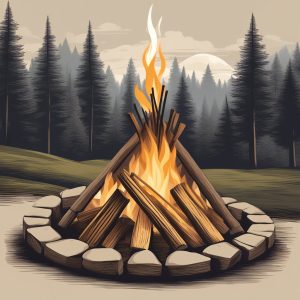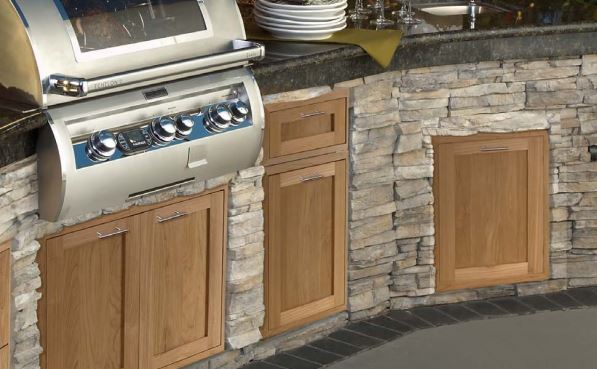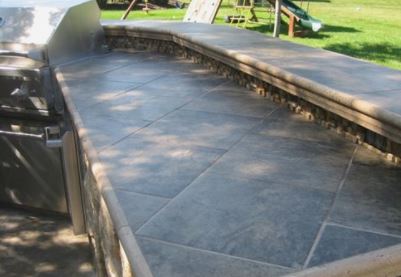How to Start a Fire in a Firepit: A Step-by-Step Guide
How to Start a Fire in a Firepit: A Step-by-Step Guide

Starting a fire in a firepit can be a fun and enjoyable way to spend an evening outdoors. Whether you’re roasting marshmallows with friends or simply enjoying the warmth of the flames, a firepit can be a great addition to any backyard. However, starting a fire in a firepit can also be a bit tricky if you’re not sure what you’re doing.
In this article, we’ll provide you with step-by-step instructions on how to start a fire in a firepit safely and easily.
Before you start your fire, it’s important to prepare your firepit and gather all the materials you’ll need.
This includes selecting a safe location for your firepit, clearing the area around it of any flammable materials, and ensuring that your firepit is clean and free of debris.
You’ll also need to gather your fire-building materials, including tinder, kindling, and fuel.
Once you have all of your materials ready, you can begin building your fire.
Building and lighting a fire in a firepit can be a bit of an art form, but with the right materials and a little bit of practice, it can be easy and enjoyable.
In the following sections, we’ll walk you through the steps you need to take to build a fire in your firepit, from arranging your materials to lighting the flames. We’ll also provide you with some tips on how to stay safe while enjoying your fire.
By the end of this article, you’ll be ready to start your own fire in your backyard firepit.
Key Takeaways
- Prepare your firepit and gather your materials before starting your fire.
- Building a fire in a firepit requires arranging your materials properly and lighting them safely.
- Always take safety precautions when starting and enjoying a fire in your firepit.
Preparing Your Fire Pit
Before you start a fire in your backyard fire pit, there are a few things you need to do to prepare the area. This will help ensure that your fire is safe and enjoyable.
Choosing the Right Location
When selecting a location for your fire pit, it’s important to keep a few things in mind.
First, make sure that the location is at least 10 feet away from any structures, including your house, garage, or shed. This will help prevent the fire from spreading and causing damage.
You should also choose a location that is away from any trees or other flammable materials.
Cleaning the Fire Pit Area
Before you start your fire, it’s important to clean the area around your fire pit.
Remove any leaves, branches, or other debris that may be on the ground.
You should also remove any ash or other debris from the fire pit itself.
Selecting Your Fire Pit Material
When it comes to selecting the material for your fire pit, there are a few options to choose from. Some popular choices include:
- Metal: Metal fire pits are durable and can withstand high temperatures. They’re also easy to clean and maintain. However, they can be expensive and may rust over time.
- Stone: Stone fire pits are a popular choice because they’re durable and can add a natural look to your backyard. They’re also relatively easy to build yourself. However, they can be heavy and may require a lot of maintenance.
- Concrete: Concrete fire pits are a good choice if you’re looking for something that’s easy to build and maintain. They’re also relatively inexpensive. However, they may crack over time and may not be as durable as other materials.
Once you’ve selected your fire pit material, you’re ready to start building your fire.
Make sure to use the right type of logs for your fire pit. Hardwood logs, such as oak or hickory, will burn longer and hotter than softwood logs, such as pine or cedar.
You should also consider using sand or rocks to create a base for your fire pit, as this will help prevent the fire from spreading.
Gathering Your Fire-Building Materials
Starting a fire in a fire pit requires three essential components: firewood, kindling and tinder, and an ignition source. Let’s take a closer look at each of these components.
Types of Firewood
When it comes to firewood, not all types are created equal.
Hardwoods like oak and birch burn longer and hotter than softwoods like pine. Kiln-dried wood is a good option for firewood because it is less likely to produce excess smoke.
It’s important to ensure that the firewood is dry before using it. Wet wood can be difficult to light and produce a lot of smoke.
Kindling and Tinder
Kindling is small sticks and twigs that are used to start the fire.
Good kindling options include dry grass, leaves, pine needles, shredded newspaper, or cotton balls.
It’s important to keep the kindling dry and fluffy to ensure it catches fire easily.
Tinder, on the other hand, is the material that catches fire from the ignition source and ignites the kindling.
Good tinder options include small dry sticks, dry grass, tree bark, or birch bark.
Ignition Sources
An ignition source is what starts the fire.
Matches or a lighter are the most common ignition sources.
Matches are a good option because they are easy to use and can be lit even in windy conditions.
Lighters are also a good option, but they can be more difficult to use in windy conditions.
Fire starters are another option to consider. They are designed to make starting a fire easier and can be purchased at most hardware stores.
Building and Lighting the Fire
Constructing the Fire Structure
Before starting a fire in your firepit, it is important to construct a proper fire structure. The two most common fire structures are the teepee and the log-cabin.
The teepee shape is great for starting a fire because it allows air to flow through the structure, which helps the fire burn more efficiently.
To create a teepee fire structure, start by placing a few small pieces of dry firewood in the center of the firepit. Then, lean smaller pieces of wood against the larger pieces in a teepee shape.
As the fire grows, you can add larger pieces of wood to the structure.
The log-cabin fire structure is another popular option. To create a log-cabin fire structure, start by placing two larger pieces of firewood parallel to each other, leaving a small gap between them.
Then, place two smaller pieces of firewood perpendicular to the first two pieces, on top of the gap. Continue alternating between larger and smaller pieces of firewood until you have built a square structure.
Igniting the Tinder
Once you have constructed your fire structure, it is time to ignite the tinder.
Tinder is small, dry materials that are used to start the fire. You can use a variety of materials for tinder, such as dry leaves, twigs, or paper.
Place the tinder in the center of the fire structure and light it with a lighter or firelighter.
As the tinder begins to burn, blow gently on the embers to help ignite the larger pieces of wood.
Maintaining and Adding Fuel
As the flames start to grow, you can begin to add larger pieces of firewood to the structure.
It is important to use dry firewood, as wet wood can be difficult to ignite and will produce more smoke.
When adding wood to the fire, be sure to place it on the structure in a way that allows air to flow through the structure. This will help the fire burn more efficiently.
To maintain the fire, you can add more wood as needed.
Keep in mind that different types of wood will burn at different speeds and produce different levels of heat output.
Hardwoods like oak and maple will burn slower and produce more heat, while softwoods like pine and spruce will burn faster and produce less heat.
Adjust the size and placement of the wood as needed to maintain the desired heat output.
Extinguishing and Cleaning Up
After enjoying a warm fire in your fire pit, it’s important to properly extinguish the flames and clean up any debris. This will ensure the safety of your property and prevent any accidents from occurring. Here’s how to put out a fire pit and dispose of ash and debris:
How to Put Out a Fire Pit
- Smother the fire: Use a shovel to spread the ashes out and remove any unburnt wood. Then, smother the fire with sand or dirt until it is completely out. You can also use a fire extinguisher if you have one nearby.
- Use water: If sand or dirt is not available, you can use water to extinguish the fire. Slowly pour water over the fire, making sure to cover all areas until the flames are completely out. Be careful not to use too much water, as this can create a muddy mess.
- Monitor the fire: Even after the fire appears to be out, it’s important to monitor it for several hours to ensure that no embers reignite. Use a shovel to stir the ashes and check for any hot spots.
Disposing of Ash and Debris
- Wait for the ashes to cool: Never attempt to dispose of hot ashes or debris. Wait until they have cooled down completely before handling them.
- Use a shovel: Use a shovel to scoop the ashes and debris into a metal bucket. Do not use a plastic bucket, as it can melt from the heat.
- Dispose of the ashes: Once the ashes are in the bucket, you can dispose of them in a safe manner. You can either bury them in your garden or take them to a designated ash disposal area.
Frequently Asked Questions
What materials are best for kindling when starting a fire in a firepit?
When starting a fire in a firepit, it is best to use dry kindling materials like dry twigs, small branches, and dry leaves. These materials ignite easily and help to build a steady flame.
Pine needles, shredded newspaper, napkins, or cotton balls are also great options. You should avoid using large logs as kindling as they are not easy to light.
What steps should be followed to safely light a fire in a metal firepit?
To safely light a fire in a metal firepit, follow these steps:
- Clear the area around the firepit of any flammable materials.
- Place a layer of sand or gravel at the bottom of the firepit. This will help to prevent the fire from spreading.
- Stack the firewood in a teepee or log cabin style.
- Place kindling materials in the center of the stacked firewood.
- Light the kindling with a lighter or match.
- Once the fire is burning steadily, add more firewood as needed.
How can you start a fire in a firepit using charcoal?
To start a fire in a firepit using charcoal, follow these steps:
- Place a layer of charcoal briquettes at the bottom of the firepit.
- Use a chimney starter or lighter fluid to ignite the charcoal.
- Once the charcoal is lit, wait for it to turn white and ashy before adding more charcoal or cooking food.
What is the proper way to use a fire starter kit in a firepit?
A fire starter kit can be a great tool to help you start a fire in a firepit.
To use a fire starter kit, follow these steps:
- Place the fire starter kit in the center of the firepit.
- Stack the firewood around the fire starter kit.
- Light the fire starter kit with a lighter or match.
- Once the fire is burning steadily, add more firewood as needed.
Is it necessary to use lighter fluid when starting a fire in a firepit?
No, it is not necessary to use lighter fluid when starting a fire in a firepit.
Using lighter fluid can be dangerous and can cause flare-ups. Instead, use dry kindling materials to start the fire.
What should be placed at the bottom of a firepit before igniting the fire?
Before igniting the fire in a firepit, it is best to place a layer of sand or gravel at the bottom of the firepit. This will help to prevent the fire from spreading and will also help with drainage.
Avoid using rocks or concrete as they can crack or explode when exposed to high temperatures.






